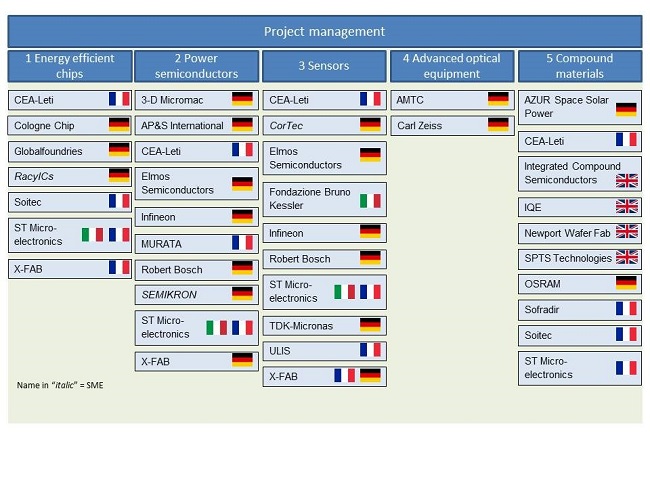Analytics, Education and Science, EU – Baltic States, Innovations, Modern EU, Technology
International Internet Magazine. Baltic States news & analytics
Thursday, 08.01.2026, 15:00
Perspective directions for Latvian science and research
 Print version
Print version |
|---|
Four EU states
(France, Germany, Italy and the UK) decided to provide in the coming five years
about €1.75 bn for research and innovation in microelectronics; this funding is
expected to unlock an additional €6 bn in private investment.
At the end of November 2018, France, Germany, Italy and the
UK jointly notified to the Commission of their intentions to activate and support
research and innovation in microelectronics as a so-called “important project
of common European interest, IPCEI. Microelectronic devices are usually seen as
small electronic components made of semiconductor materials such as silicon.
The basic microelectronic components, commonly known as chips and sensors, can
be found in almost all electronic devices.
It is expected that the integrated research and innovation
project will involve about 30 direct
participants situated in both inside and outside the EU. They are mostly
industrial actors but also two research organisations, carrying out 40 closely
interlinked sub-projects. These direct participants will work in collaboration
with a large number of partners, such as other research organisations or SMEs,
including other EU states besides the mentioned four.
Short history
In June 2014 the Commission adopted a Communication on
Important Projects of Common European Interest, IPCEI setting out criteria
under which the EU states can support transnational projects of strategic
significance for Europe in line with the TFEU art 107(3,b). This framework aims
to encourage the states to support projects that make a clear contribution to
economic growth, jobs and competitiveness in Europe.
On projects of common EU interests in:
https://eur-lex.europa.eu/legal-content/EN/TXT/?uri=uriserv:OJ.C_.2014.188.01.0004.01.ENG;
the Communication is valid until December 2020.
The IPCEI framework complements state aid rules such as
the “General Block Exemption Regulation and the Research,
Development and Innovation Framework, GBER” (from 2014), which allows
supporting innovative projects whilst ensuring that potential competition
distortions are limited. See press release: http://europa.eu/rapid/press-release_IP-14-586_en.htm
The EU state aid scoreboard shows that more than 95% of new research/development/innovation (R&D&I) measures granted under the GBER could be disbursed quicker. Latest Commission’s data on total spending for R&D&I under the GBER-2014 continued to increase reaching about €5.7 bn in the EU-28 states.
The IPCEI rules support states’ financing for R&D&I in
industrial deployment on condition that the projects receiving such funding are
highly innovative and do not cover mass production or commercial activities.
They also require extensive dissemination and spillover commitments of new
knowledge throughout the EU and a detailed competition assessment to minimise
any undue distortions in the internal market.
In order to qualify for support under the IPCEI
Communication, a project must: (i) contribute to strategic EU objectives, (ii)
involve several EU member states, (iii) involve private financing by the
beneficiaries, (iv) generate positive spillover effects across the EU that
limit potential distortions to competition, and (v) be highly ambitious in
terms of research and innovation.
In assessment of
the microelectronics IPCEI, the Commission notes that:
- investment in research and innovation in microelectronics at this scale is a major transnational innovation project. It carries a considerable element of risk, and therefore public support is appropriate and necessary to incentivise companies to carry out these ambitious research, development and innovation activities.
- the
results of the research project will be disseminated by participating
companies benefiting from the public support. In this context, an annual
conference on the project will be organised, and interested parties will
be informed in a timely manner of the technological innovation and the new
knowledge generated in this project via a dedicated website. Furthermore,
companies will host a series of technical events on their respective
sub-projects; and
- a
governance structure composed of representatives from the participating states,
businesses and the Commission will supervise the project and monitor in
particular the progress of the individual participants and their partners
as well as the sharing of research innovation results beyond the project
participants.
Microelectronics’ importance
The importance of microelectronics
in modern human activities is huge: these devises can be found almost in all
electronics such as phones, computers, washing machines and the cars. The Commissioner
in charge of the EU’s competition policy, announced at the end of December 2018
a creation of a special EU state aid program
with the rules which would help the states to promote risky and groundbreaking
research and innovative solutions while ensuring that the incurred benefits would
be shared widely and did not distort the level playing field in the EU. Commissioner
for the EU digital economy and society underlined that almost all digital services in Europe depend on microelectronic
components that have already become smaller and faster. In order not to depend
on other global powers in such essential technology, e.g. for security or
performance reasons, the EU states have to be able to design and produce these
components themselves.
The microelectronics
projects general objective is to enable research and develop innovative
technologies and components (e.g. chips, integrated circuits, and sensors) that
can be integrated in a large set of downstream applications. These include
consumer devices, for example home appliances and automated vehicles, and
commercial and industrial devices, for example the management systems for
batteries used for electric mobility and energy storage.
In particular, the project is expected to stimulate
additional downstream research and innovations in particular in relation to the
broad area of the Internet of Things and to connected or driverless
cars.
The 4-states’ project participants and their partners will
focus their work on five different micro-technology areas:
= Energy efficient chips: developing new solutions to
improve the energy efficiency of chips, which e.g. would reduce electronic
devices’ overall energy consumption;
- Power semiconductors: developing new technologies
of components for smart appliances as well as for electric and hybrid vehicles,
to increase the reliability of final semiconductor devices.
- Smart sensors: developing new optical, motion or
magnetic field sensors with improved performance, enhanced accuracy and improve
car safety;
- Advanced optical equipment: developing more
effective technologies for future high-end chips; and
- Compound materials: developing new compound
materials (instead of silicon) and devices suitable for more advanced chips.
All five technology fields are complementary and interlinked:
e.g. chips are not typically sold by themselves but are often supplied as part
of an integrated system. Such systems require a combination of processes and
technologies covered by the different fields of the project. For this reason,
the project participants will be involved in over 100 collaborations across the
different areas in the 40 closely interlinked sub-projects.
Funding beneficiaries and amounts
four EU states. The direct participants could receive by the
respective national administrations a total of up to approximately €1.75 bn in
funding. More specifically, France has sought approval to grant aid provide
funding of up to €355 bn, Germany up to €820 bn, Italy up to €524 bn and the UK
up to €48 bn.
The following are the direct participant states supporting
different project areas:

Some issues have
been raised concerning the connection of public funding for the integrated
project in microelectronics with the European rules for state; however, the
Commission acknowledged that supporting microelectronics contributes to a
common European interest and in that sense are complied with the EU state aid
rules. That means that this sphere of research can be extensively financed from
the state budget without violating EU’s competition rules. Research and innovation in microelectronics can help the
states in supporting the emerging market as soon as it alone cannot take the
risk. The Commission’s decision is a result of enhanced cooperation and shared
European vision in the most advanced technology’s sphere.
General reference:
Commission press release/18.xii.2018 in:
http://europa.eu/rapid/press-release_IP-18-6862_en.htm?locale=en








 «The Baltic Course» Is Sold and Stays in Business!
«The Baltic Course» Is Sold and Stays in Business!

